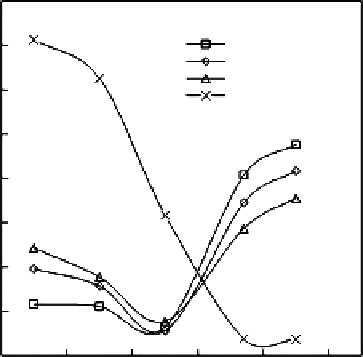Biomedical Engineering Reference
In-Depth Information
than that of chitosan hydrogels [16]. When pH is equal to isoelectric point (p
I
) of chitosan-
based amphoteric cross-linking hydrogels, the numbers of -NH
2
and negative groups are
equal and ionic interactions between opposite charges result in the lowest swelling degree.
When pH > p
I
, a larger concentration of negative groups inside the hydrogels are ionized,
which results in an osmotic pressure and makes the amphoteric cross-linking hydrogels
swell, and the swelling degree increases with increasing pH. When pH < 7, the dissocia-
tion of carboxyl groups is inhibited and -NH
2
is protonated. When pH < p
I
, the dominant
ionic groups of amphoteric cross-linking hydrogels are -NH
3
+
, and the swelling increases
with decreasing pH. The effect of substitution degree (SD) on swelling degree is somewhat
“complex.” The swelling degree is almost unchanged when pH = p
I
. When pH < p
I
, the
swelling degree of amphoteric cross-linking hydrogels increases with decreasing SD.
However, when pH > p
I
, the opposite phenomenon can be observed. For example, the
higher the SD value that
N
-(2-carboxybenzyl) chitosan cross-linking hydrogels (CBCSG)
possess, the bigger the swelling degree it exhibits in the pH range 7.4-9.0. In the pH range
1.0-5.0, the result is contrary to the above-mentioned results (
cf.
Figure 5.7) [17]. Yang et al.
[18] found that poly(acrylic acid)-modified chitosan-based cross-linked hydrogels exhibit
similar swelling behaviors.
5.2.2.2 Chitosan-Based Semi-IPN Hydrogels
At low pH, the swelling process of the chitosan-based semi-IPN involves the protonation
of amino groups in the gels and relaxation. The equilibrium swelling degree of semi-IPN
hydrogels increases and the semi-IPN becomes more pH sensitive with decreasing cross-
linking degree. However, at high pH, where there are no protonation and hydrogen bond-
ing association, there is almost no effect of cross-linking degree on the equilibrium degree
of swelling and pH sensitivity. In addition, with decreasing chitosan content in the semi-
IPN, the semi-IPN becomes less pH sensitive.
16
14
CBCSG2
CBCSG4
CBCSG5
12
CSG
10
8
6
4
2
0
0
2
4
6
8
10
pH
Figure 5.7
Swelling characteristics of the CBCSG with different SD values in different buffer solutions for 24 h. SD: CBCSG2
(2.62 mmol/g), CBCSG4 (2.10 mmol/g), CBCSG5 (1.64 mmol/g), and CSG2 (0).

Search WWH ::

Custom Search